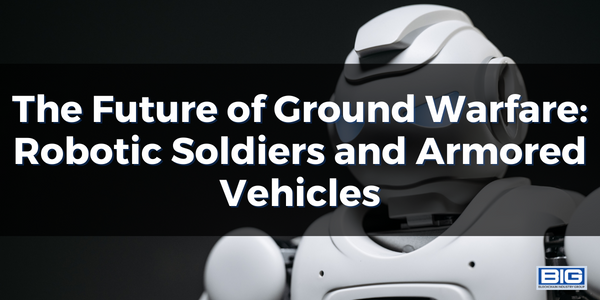
While drones have revolutionized warfare from the skies, the next frontier of military innovation lies in the realm of ground combat.
In this article, we explore the future of ground warfare, envisioning a scenario where robotic soldiers and armored vehicles dominate the battlefield. With advancements in robotics and artificial intelligence (AI), the landscape of ground warfare is on the cusp of significant transformation.
Unleashing Robotic Soldiers on the Battlefield
In this imagined future scenario, advanced robotic soldiers equipped with AI systems form the backbone of ground forces. These humanoid or quadrupedal robots possess the ability to operate autonomously or under human supervision, leveraging their agility, strength, and advanced sensors to navigate complex terrains and engage in combat.
Phase 1: Reconnaissance and Target Acquisition
Robotic soldiers, with their enhanced sensors and AI capabilities, take on the critical role of reconnaissance and target acquisition on the battlefield. They stealthily move through challenging environments, collecting real-time data on enemy positions, defensive structures, and potential threats. This information is relayed to human commanders or AI command centers, forming the foundation for strategic decision-making.
Example: Covert Reconnaissance Maneuvers
Equipped with advanced camouflage technology and silent movement capabilities, robotic soldiers conduct covert reconnaissance maneuvers. They infiltrate enemy lines, gathering crucial intelligence while minimizing the risk to human personnel. These robotic scouts transmit valuable data back to the command center, enabling commanders to develop informed strategies for subsequent phases of the battle.
Phase 2: Collaborative Offensive Operations
In the collaborative offensive operations phase, robotic soldiers work in coordination with human soldiers or other robotic units to execute complex combat maneuvers. Through AI-driven algorithms and real-time communication, they devise tactical plans, engage in synchronized assaults, and adapt their strategies based on the evolving battlefield dynamics.
Example: Combined Arms Assault
Robotic soldiers, working alongside human troops or robotic armored vehicles, engage in a combined arms assault. AI algorithms analyze the data from reconnaissance missions and assess the optimal approach for achieving mission objectives. Robotic soldiers utilize their agility, precision, and firepower to neutralize enemy targets while minimizing the risk to human lives. This collaborative effort leverages the strengths of both human and robotic forces, maximizing the effectiveness of ground operations.
Phase 3: Robotic Armored Vehicles and Tanks
In this future scenario, robotic armored vehicles and tanks play a pivotal role in ground warfare. These AI-controlled war machines are equipped with advanced weaponry, defensive systems, and sensor arrays, making them formidable assets on the battlefield. They operate autonomously or under human supervision, providing armored support, strategic positioning, and heavy firepower.
Example: Armored Offensive and Defensive Maneuvers
Robotic armored vehicles and tanks form the backbone of ground assaults and defensive positions. AI algorithms analyze real-time battlefield data, identifying optimal routes, defensive positions, and enemy vulnerabilities. These robotic war machines utilize their superior firepower, mobility, and defensive capabilities to engage in offensive maneuvers or provide cover and support to advancing infantry. With their advanced sensor suites, they can detect and neutralize threats with speed and precision, outperforming traditional armored vehicles.
44 Innovative Artificial Intelligence Companies
—
5 Benefits of Artificial Intelligence Technology
—
A Brief History: Artificial Intelligence (AI)
Navigating the Future of Ground Warfare
As the future of ground warfare evolves with the integration of robotic soldiers and armored vehicles, it is crucial to address ethical considerations, ensure appropriate human oversight, and prioritize the safety of civilian populations. Discussions on international laws and regulations governing the use of autonomous systems in warfare become paramount, as the boundaries of traditional conflict are redefined.
While the potential of robotic soldiers and armored vehicles promises enhanced battlefield capabilities, responsible deployment and comprehensive risk assessments are essential. The future of ground warfare must strike a delicate balance between leveraging the advantages of robotic soldiers and armored vehicles while upholding ethical standards and minimizing unintended consequences.



